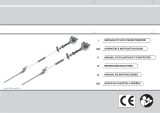
20
GB
of injury and is prohibited. Do not fit the
impeller to other engines or transmissions.
19. When disposing of an old blower at the end
of its useful life, think of the environment.
Take your old unit to your dealer who will be
able to dispose of it in a proper manner.
20. Only experienced persons who are familiar
with the operation and safe use of this
machine should use the blower. If you lend
the blower to someone, also give them the
instruction manual and ensure that they read
it before using the machine.
21. Do not use the blower near electrical
equipment.
22. Do not obstruct the air intake of the impeller.
23. Keep your hands away from the impeller
when the engine is running.
24. Please note that the owner or the user is
responsible for any accidents or damage to
third parties or their property.
25. All saw service, other than the operations
shown in the present manual, should be
performed by competent personnel.
26. Do not hit or force the blades of the impeller;
do not use a blower with a damaged impeller.
SAFETY PROTECTIVE CLOTHING
While working with the blower, always
use safety protective approved clothing. The
use of protective clothing does not eliminate
injury risks, but reduces the injury effects in case
of accident. Consult your trusted supplier to
choose an adequate equipment.
The clothing must be proper and not an obstacle.
Wear adherent protective clothing. Protective
jackets and dungarees are ideal.
Do not wear clothes, scarfs, ties or bracelets that
can stuck into twigs. Tie up and protect long hair
(example with foulards, caps, helmets, etc.).
Safety shoes having skid-proof sole and anti-
piercing insert.
Wear protective goggles or face screens!
2. The blower must only be used by adults in
good physical condition who are familiar with
the operating instructions.
3. Do not operate the blower when tired or
fatigued or under the effect of alcohol and
drugs.
4. Always wear gloves, safety glasses and
hearing protectors. Do not wear scarves,
bracelets or any other items that could get
caught up in the impeller.
5. Do not allow other persons or animals near
when starting or using the blower.
6. Always work from a safe, stable position.
7. Do not direct the air jet towards people or
animals.
8. Only use the blower in well-ventilated
areas. Do not use in explosive atmospheres,
in enclosed areas or near inflammable
substances.
9. Check the blower daily to ensure that
all safety and other devices are working
properly.
10. Long hair should be worn securely tied up
(e.g. in a hair net).
11. Do not use a blower that has been damaged,
badly repaired, improperly assembled or
modified. Do not attempt to remove or
bypass any of the safety devices.
12. Retain this manual and consult it before using
the blower.
13. Always follow the care and maintenance
instructions.
14. Do not attempt to carry out any servicing
or repairs other than normal maintenance
yourself. Contact your authorised service
centre.
15. All labels with health hazards must be kept
in good conditions. In case of damage or
deterioration, immediately substitute them
(Fig. 19).
16. Do not utilize the machine for uses different
from the ones specified in the manual (see
pag. 26).
17. Never leave the machine unattended with the
engine running.
18. It is prohibited to fit an impeller other than
that supplied by the manufacturer. The use
of other accessories could increase the risk






















